Is An Economic Recession Coming?
Monthly Market and Economic Update – July 2022

Peter Flannery Financial Adviser CFP
“If you have one economist on your team,
it’s likely that you have one more than you’ll need.”
Warren Buffett
Key Points:
- Recession is looming.
- What does it mean for investors?
- Inflation continues to rise.
- Interest rates continue to rise.
- Markets remain unsettled.
- With all this negativity, are we actually getting closer to a market turnaround?
THE MARKETS
Markets Focus on Rising Interest Rates and Slowing Economic Growth
Unlike most of the last 10 years or so, where the market was brave and it took a lot to get the market to even think about being worried, we now live in an environment where the market is spoilt for choice in terms of things to worry about. In other words, market sentiment has gone from being too brave, to now being fragile to fearful.
As you know, ‘fear’ and ‘opportunity’ go well in the same sentence (for us).
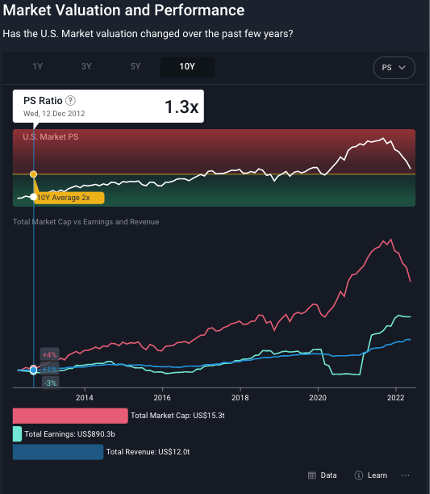
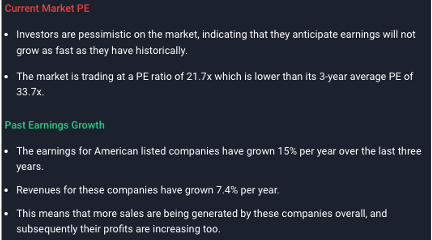
Ths diagram shows the price to sales ratio (the white line near the top) along with earnings, revenue, and total market capitalisation of the US market.
Charts like the one above are interesting. The only thing is though, they are historical.
Still, useful in terms of understanding where we’ve been and where we are now to some degree.
They offer little in the way of insights into each of the businesses within your portfolio but offer the macro view if you’re looking at the big picture with regards to (in this case above) the US share market.
I know I talk a lot about the US market. That’s because, by some measures, they are the largest in the world and therefore what goes on in America matters to us.
The Price to sales ratio by the way is not a bad way to value markets and individual businesses. In my opinion, it can be more reliable in some ways than everyone’s favourite, the price to earnings (P/E) ratio.
Talking generally, a price to sales ratio of less than one is good. A price to sales ratio of two is okay, although starting to look slightly expensive. It does depend on the individual business to some degree though.
Interestingly, Tesla’s price to sales ratio is approximately 12.3 – very expensive. By comparison, PayPal’s price to sales ratio is 3.27.
The price to sales ratios for Alphabet (Google) and Apple sit at around 6.0.
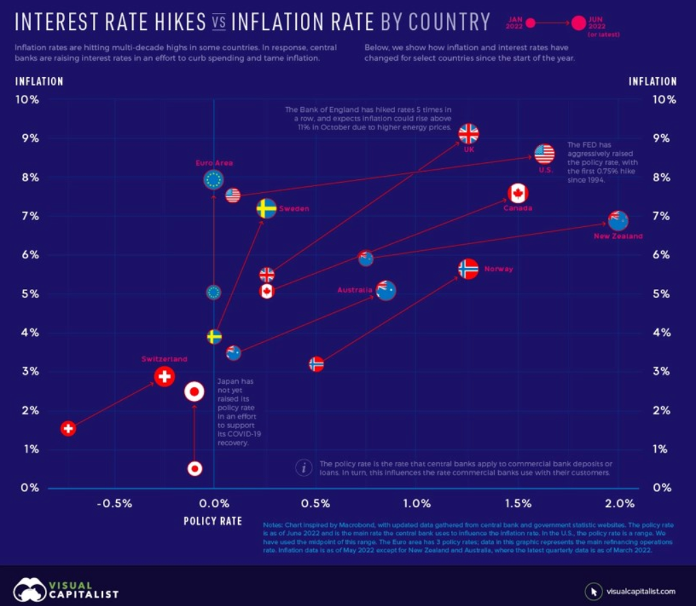
The above graph shows the movement of interest rates for various countries around the world (the horizontal axes) and compares it with levels of inflation (the vertical axes).
Inflation, rising interest rates, and economic growth are among the main indicators that the market is watching closely at the moment.
The debate as to whether the US economy will slide into recession continues. It appears unclear still.
Although others have a different view, in my opinion I see a 60 percent possibility in favour of economic recession over the next couple of years, which means that it’s not inevitable, but more than possible. Either way, it won’t worry us because lower prices will allow value to emerge across markets and also inside your portfolio.
As an aside, if you still don’t like the cash-up value of your portfolio fluctuating on the downside, consider the current environment as “investor training on volatility”?
Seriously though, those of us that focus on the big picture, minimising the noise that exists around the current data, we can be better placed to make good decisions around investing in the midst of all the noise. We are clear in our thinking. We are confident as we sit tight and, when pricing allows, adjust our portfolios.
Will markets go lower?
Trading prices across markets to some degree are determined by interest rates and the outlook for economic growth, as well as company earnings growth levels.
Simply, trading prices tend to rise when the market sees profit increasing in the future, and of course prices can decline when the market sees profits slowing or declining.
If we assume that this year’s earnings forecast remains on track and is followed by a mild 20% decline next year, this could see the price earnings ratio for the market bottoming at around 17X (from around 19.5X now). This would see the S&P 500 index target around the 3000 mark (currently around 3899 as at 11 07 2022).
Let’s say that earnings growth this year is reduced to only 5% with a 40% decline over 2023, this could see the price earnings (P/E ratio bottom out at 15X). This could mean an S&P 500 possibly below 2000.
The bottom line is that US equities markets have priced in economic recession to some degree but not fully. This means that should a recession materialise (it’s still open to debate) then markets could potentially drop lower still.
This would need a number of other variables to line up as well. For example, unemployment remains low and consumer sentiment / spending remains reasonably robust at the moment. While those two indicators remain in place, recession is less likely.
All that said, we’re not in the business of looking to time the markets. It doesn’t hurt though, to be aware of our environment—because, after all, we invest in it.
Still, the quality of the businesses in which we invest is much more important longer term than the market’s view on interest rates, earnings, and economic growth now.
So, let’s be aware but let’s keep our eye on what matters.
Oh, and did I mention that sitting tight is sometimes a good thing?
At the same time, I should add that we are getting closer to more favourable individual business pricing. Adding to certain positions will be beneficial. Sitting tight is a short-term tactic, not a long term strategy, that’s for sure.
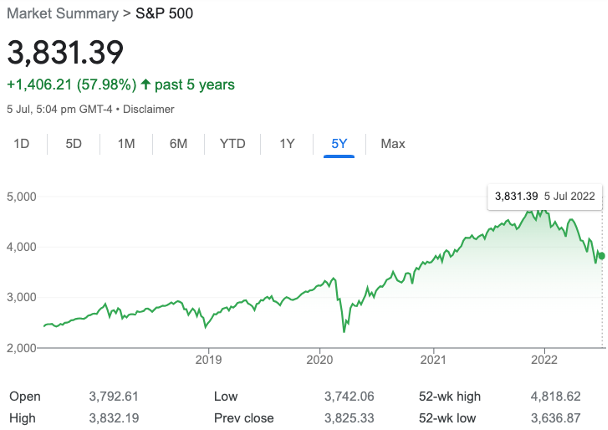
The above graph tracks the Standard and Poor’s 500 share market index in America.
Perhaps I should add that this communique is specifically about markets, not individual business investment opportunity. The point being, whilst it’s useful to be aware of the environment, we shouldn’t let this type of information — which, by the way, is somewhat high level and speculative — colour our thinking about our investment opportunity in the future.
The Global Economy
Slowing global economic growth
Global economic growth is slowing. Apart from Russia, that means slowing growth, not no growth. Indeed Russia looks as though its economy will continue to contract.
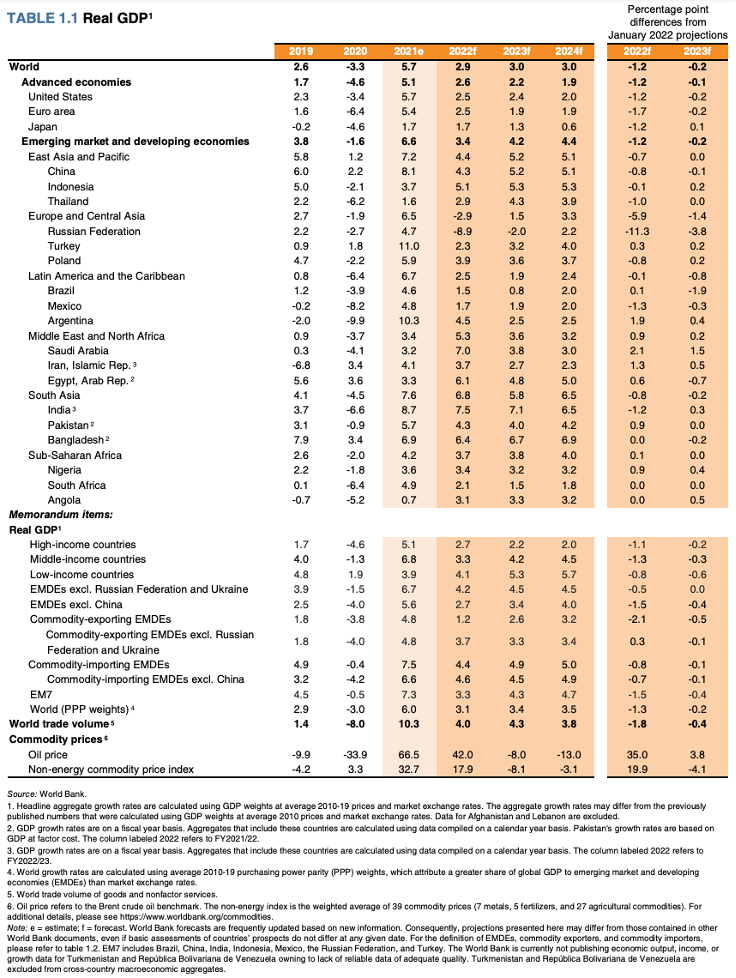
The above table shows economic growth for the global economy and specific countries around the world.
Notably, to the right hand side it shows the reduction in economic growth from previous projections.
Although markets and economies are a random walk and anything is generally possible, what we have currently is slowing economic growth in the future.
We could have recession on a global scale. This would worry the markets. That’s because markets don’t like anything other than growth. However, this is simply the state of play, not the killer of opportunity, not at all.
As a client of WISEplanning you know that lower trading prices, whilst they may mean your portfolio cash up value declines for a time, is temporary. You know that the lower prices go, the better the buying value.
When we look at where we’ve been, what we know is:
- the Ukraine war emerged;
- the Coronavirus created economic imbalances;
- as a result of supply chain constraints, inflation spiked;
- as a result of inflation, interest rates are now on the rise; and
- trading prices across markets have declined sharply, which has turned out to be the sharpest decline since 1976 by some measures. That’s why you’ve probably noticed it!
So, we now have inflation:
- The Russian aggression could last for quite some time, rising food prices could create political instability in some countries, trade barriers could rise once again.
- Basic essential living costs may now drive inflation rather than the previous discretionary purchases of the past.
- Low unemployment, tight labour markets, and rising wages’ costs add to inflation pressures.
- Rising energy costs also contribute to inflation pressure.
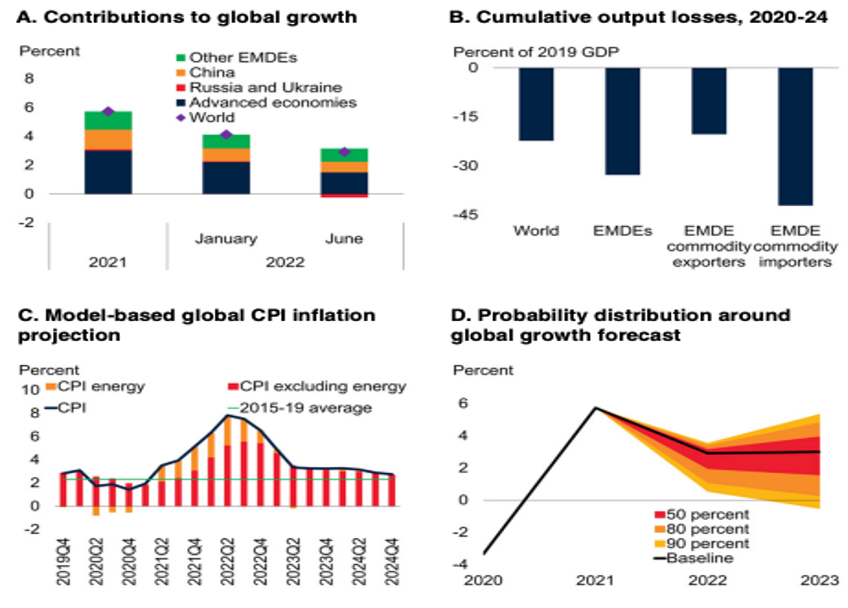
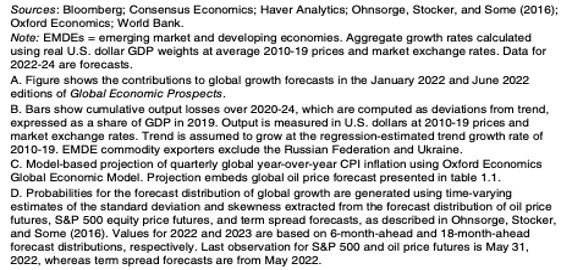
The bar graph top left shows which countries or areas are contributing to global economic growth.
The bar graph with the black bars dropping below zero (top right) breaks down the effect of output losses from 2020 through 2024.
The bar graph bottom left projects inflation globally.
The graph bottom right forecasts global economic growth variables. The black line shows the baseline for the consensus view.
Global markets read into what it thinks is going on in the future with regard to the global economy.
Simply, when the market sees slowing economic growth, it translates this to mean slowing profits for companies in which they invest. The market then decides to get choosy, and because most participants in the market “play the market”, they are happy to bail out of an investment, looking for greener pastures elsewhere as quickly as possible.
We know that over the next year or so, global economic growth looks to be slowing (not contracting, except for Russia). Slowing growth is not a recession.
Inflation by some projections might peak at some point over 2022 or early 2023, although remaining at a higher level than we’ve seen for many years.
At this stage it’s difficult to see anything like hyperinflation, as some commentators have suggested.
What’s more likely is the usual cycle of supply and demand, which plays itself out to the point where for example, low unemployment drives demands for higher wages, gets to the point where it becomes unsustainable, and lay-offs emerge.
We’ve already seen this with the likes of Tesla and other companies, although at this stage it is limited.
Once this takes hold, then consumer spending usually continues to slow down, which in turn can slow inflation. Simply, there needs to be some pain before there is inflationary and economic gain.
So, the outlook is changing to slower economic growth, with inflation yet to peak, and therefore more interest rate hikes are on the way.
These are conditions that markets do not like. You might be successful, however be careful about trying to time the markets.
As I mentioned to one of my clients recently, I have no place interfering with your ‘gut feel’.
Markets will probably recover before economic growth does.
To me, the best way to deal with this situation is simply to price for risk. Trading prices or the amount you pay to invest in a business, compared to its ability to generate cashflow and to grow in the future.
That is a low bar to step over compared to attempting to outwit a fragile market, which could be considered a high bar to jump over.
The United States of America
Will America slip into recession?
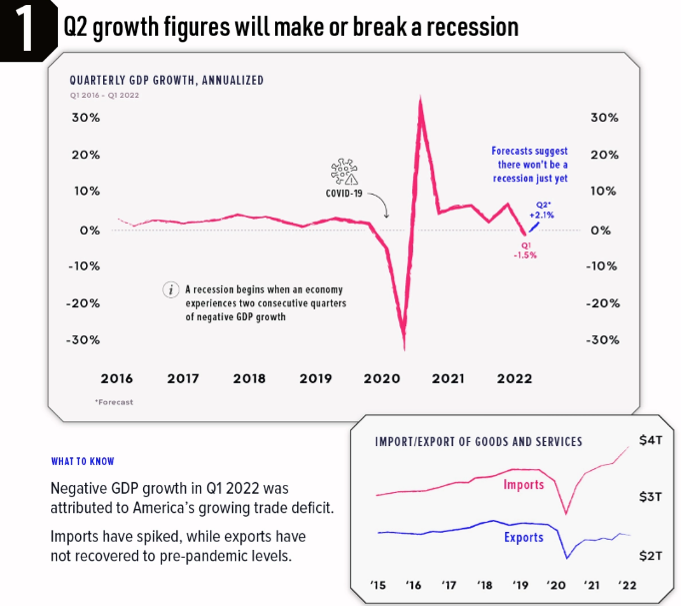
It is noteworthy that the previous quarterly US GDP contraction was attributed to some degree by the trade deficit at the time, rather than other drivers. It remains unclear as to whether or not America will slip into recession.
Although it’s not ideal and the markets worry about recessions because they see slowing growth, nonetheless as I’ve said elsewhere, a recession is a technical term for two consecutive quarters of economic contraction.
It is not a depression or anything like it. Sure, it does mean some pain across the economy and some imbalances. A recession though does not mean endless lines at soup kitchens all around the world. A recession does not mean 26% unemployment as per the 1930’s – that is an indication of a depression.
What’s worth keeping in mind about the American economy slipping into recession is that, it can spread to other economies because of the size and scale of the US economy.
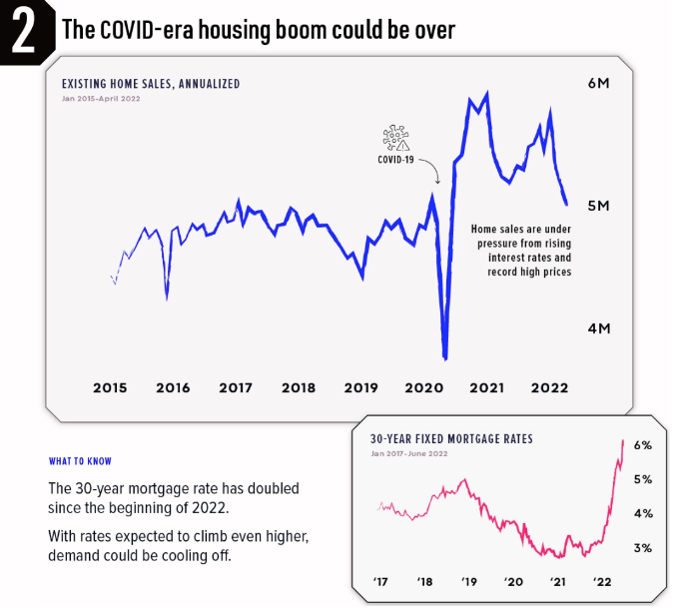
The housing boom across America has created economic activity (same here in New Zealand). This appears to be slowing down, which lines up with rising interest rates.
What’s interesting about interest rates is that they have increased significantly, but that’s because they were so low. It’s a long way up from the bottom. Interest rates are still not normalised yet. They will be in due course and that will see inevitably pressure on consumer confidence and ultimately a slow-down in consumer spending, which of course slows down inflation. It won’t be by this time next week though!
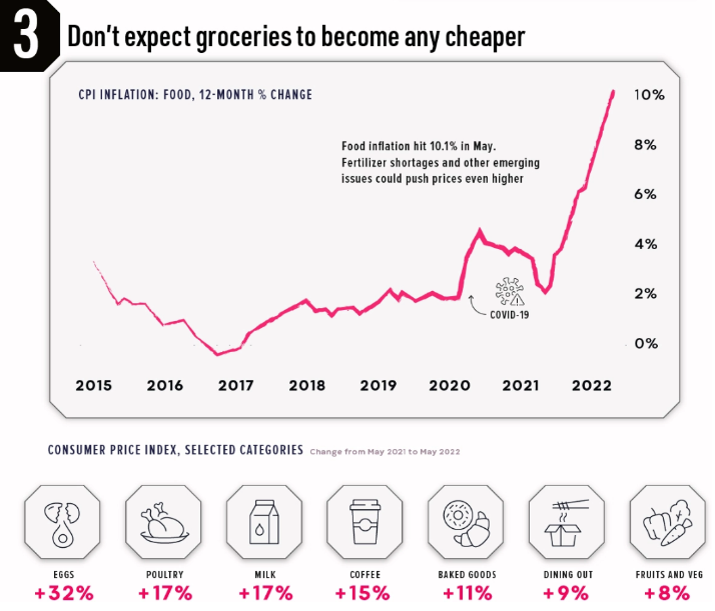
We’ve all heard about the coronavirus now for more than two years and possibly becoming tired of it. Inflation may have taken the place of the Coronavirus in terms of an annoying subject that keeps coming up. Ironically, the Coronavirus created supply chain constraints, which helped trigger spiking inflation.
Unfortunately, it impacts on everyday citizens. For example, paying $15 for a lettuce seems obscure, but that has been the reality at times here in New Zealand — and, talking with my brother in Brisbane, the same over there as well. Sounds crazy but the good news is, this sort of imbalance will move on at some point.
Inflation though will likely settle at a higher level than we’ve seen over the last 30 years or so.
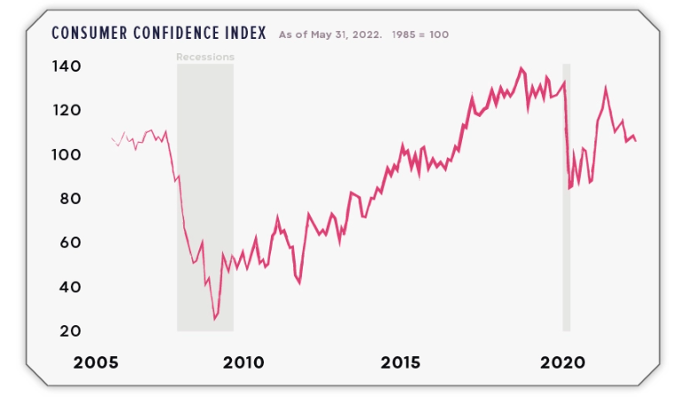
As we can see from the graph above, the red line to the right of the graph is pointing in a downward direction, which signals declining consumer confidence. It’s not severely damaged at this point but nonetheless appears to be declining.
Overall, the American economy is actually mixed but generally moving along at an okay pace, all things considered. A recession is possible but not inevitable. Markets and the economy regardless, will continue to function largely as it does at the moment, but perhaps at a slightly slower pace.
Europe
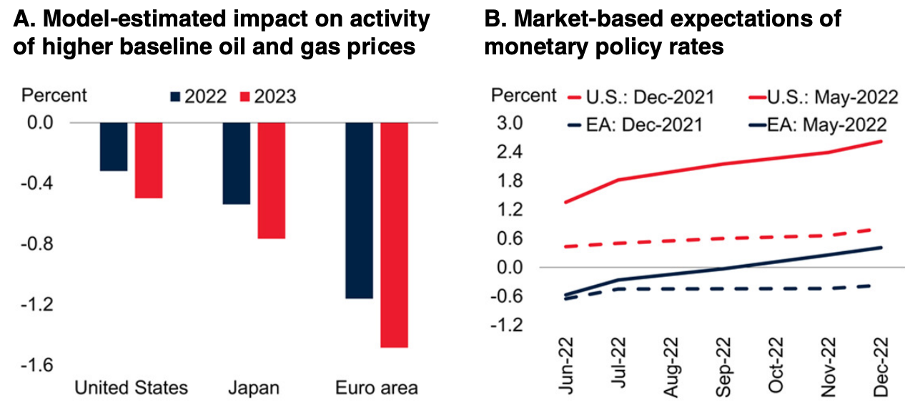
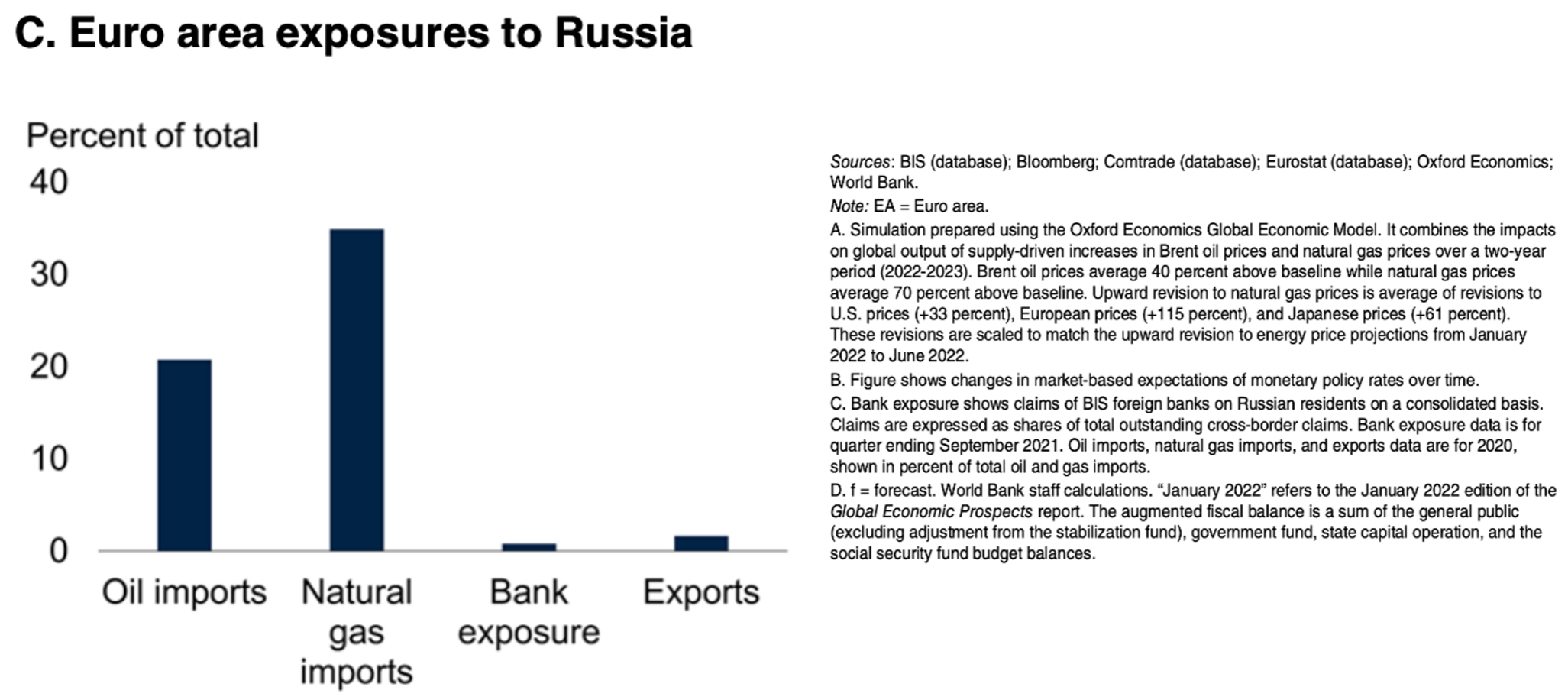
The bar graph top left shows the impact on economic activity from increased oil and gas prices. The line graph to the right shows forward projections of interest rate movements over the remainder of 2022. The bar graph with the black bars (bottom left) shows Europe’s exposure to Russia for those metrics outlined on the bar graph.
The European Central Bank, like elsewhere in the world, is raising interest rates in response to spiking inflation. Because of Europe’s reliance on Russian oil and natural gas, the Euro area is particularly vulnerable to the Ukraine situation.
Supply chain constrains persist and uncertainty continues around the implications of Russia’s actions and how that may impact economic activity across Europe moving forward.
One of the challenges is that, it’s difficult to know just how long the situation in the Ukraine will continue.
Anyway, growth in the Euro area is projected to slow to around 2.5% over 2022. However I suspect that outlook will be revised downwards again soon as the ongoing war contributes to increased energy prices, ongoing supply disruptions, along with tighter financial conditions.
Looking further ahead into the future, some estimates project economic growth to sit at around 1.9% for the European area over 2023 and 2024, as the European Central Bank continues to tighten monetary policy and those other headwinds continue.
The United Kingdom
UK – Economic Activity (GDP)
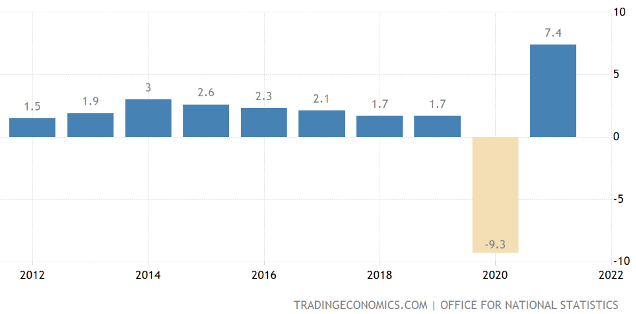
The above graph tracks economic activity in the UK, as measured by gross domestic product (GDP).
Economic growth in Britain has recently been moving at a solid pace, although of course, it’s only catching up from the significant contraction as a result of the Coronavirus.
Looking ahead, some estimates suggest that economic growth in the UK may average somewhere between 2.8% and 3.8% over 2022. This is down from previous estimates of around 4.5%.
In short, whilst the outlook is not dire, economic growth appears to be slowing. This is due it seems to possibly slower household consumption, which in turn is likely driven by higher commodity prices.
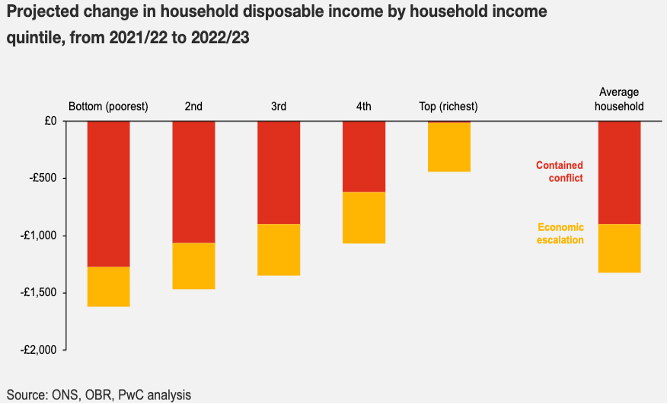
The above graph shows the projected change in household disposable income according to those income categories outlined on the graph.
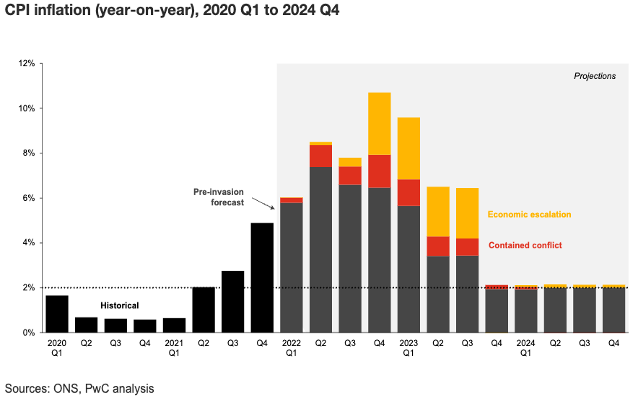
The above graph tracks inflation looking back in the past and offers a projection moving forward under a couple of different scenarios.
Like elsewhere in the world, inflation in Britain has spiked significantly.
In February for example, inflation reached 6.2% which was the highest level of inflation in 30 years. It is quite high to be fair, although understandable when you think that we’ve had 30 years of low interest rates and low inflation. Therefore, a 30-year high is actually not as dramatic as it may seem.
The Ukraine situation does add to inflation. The graph above details these two scenarios:
- Contained conflict scenario:
The war in Ukraine adds an extra one percentage point to the average annual inflation projection. - Economic escalation scenario:
Inflation across Britain hits a 40-year high of around 11% in the fourth quarter of 2022, with energy prices set to increase by around 75%.
On another note, Boris Johnson was under attack once again with at least two of his key cabinet members having resigned and many others suggesting that Boris Johnson should do the same.
He has since resigned. This type of event is distracting for government although it will have limited impact on the economy, particularly in the long run.
Australia
Australia – Economic Activity (GDP)
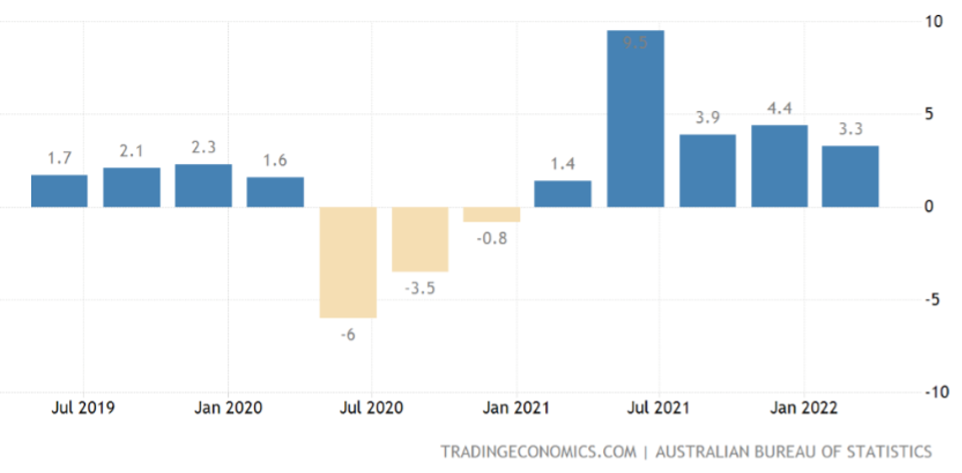
The above graph tracks economic activity in Australia, as measured by gross domestic product (GDP).
The Australian economy has been holding up reasonably well compared to other countries around the world, all things considered.
They are still having to deal with spiking inflation, supply chain constraints, and the need to raise interest rates to get ahead of the inflation curve.
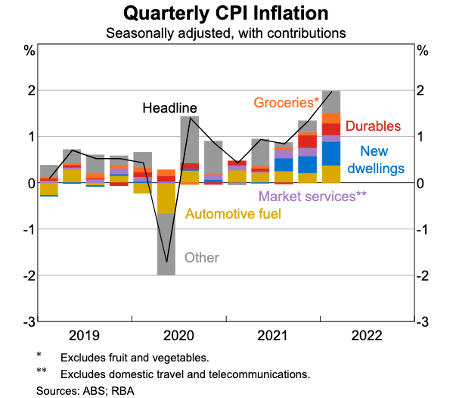
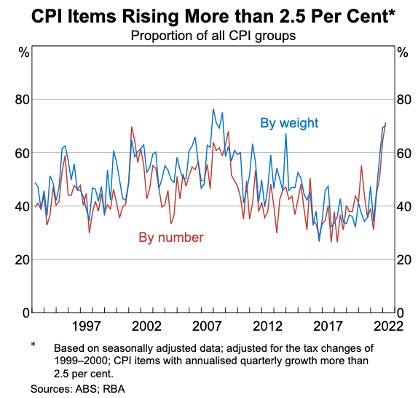
The above graph to the left shows inflation and what the main contributors are, driving inflation up.
The graph to the right highlights the amount of goods and services that are spiking by more than 2.5%, by weight and by number.
Inflation continues to rise, coming in at around 5.1 percent for the year ended March 2022. Further interest rate rises will likely be necessary for Australians in the not too distant future.
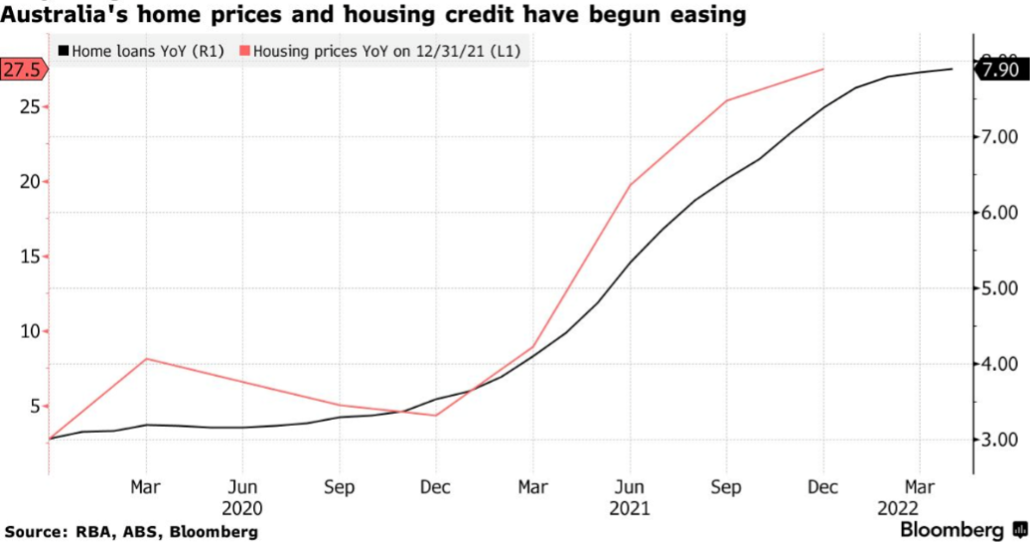
The above graph tracks home loan activity and house prices across Australia.
Like New Zealand and some other countries, Australia’s residential property prices are expensive by any measure you care to use.
One study showed that an average Syndey couple’s ability to service a mortgage could decline by more than 20% by the end of 2022, based on a model that uses the average income of AUS$141,000.
Anyway, interest rate increases currently on the way might be larger and come at a more rapid pace, according to ANZ Bank’s senior economist.
Although future estimates can be speculative, one estimate suggests that national house prices could decline by 15% over 2023, 13% in 2024, and then 11% the following year, which would amount to a cumulative decline of 30%.
That seems like a lot, although Australians, like Kiwis and others around the world, are not used to high interest rates. Simply, high interest rates affect the ability of the borrower to service the loan.
So, the Australian economy continues to grow at a modest pace and arguably is doing as well as many other countries around the world. Good news because New Zealand trades quite a bit with Australia.
New Zealand
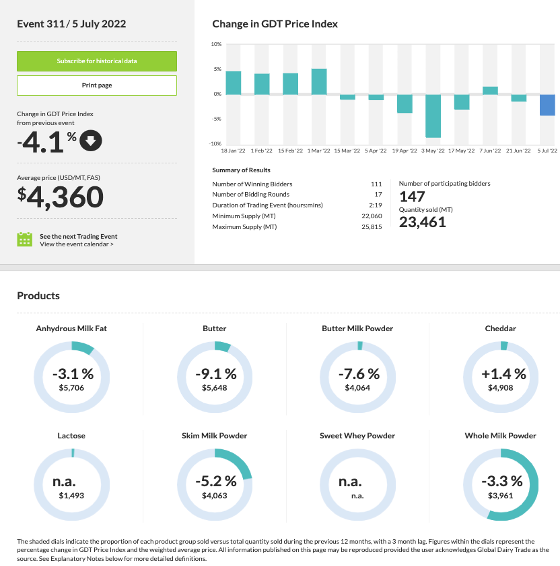
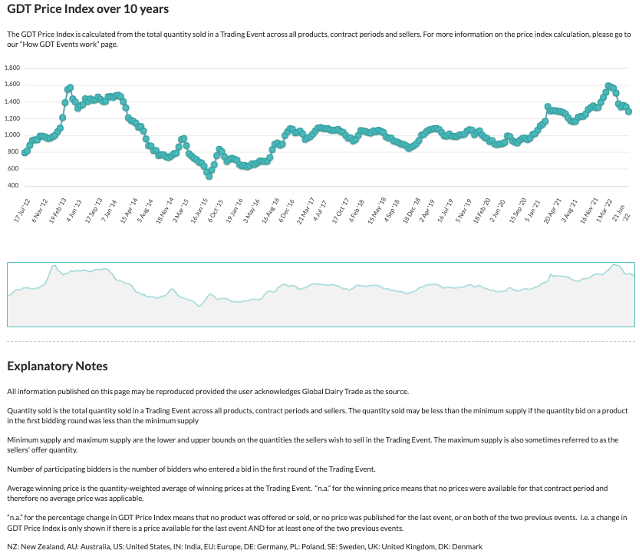
Dairy prices rose consistently in the early part of 2022 but have subsequently declined since March. This is important for us because dairy is a significant contributor to the financial wellbeing of New Zealand.
New Zealand – Inflation Rate
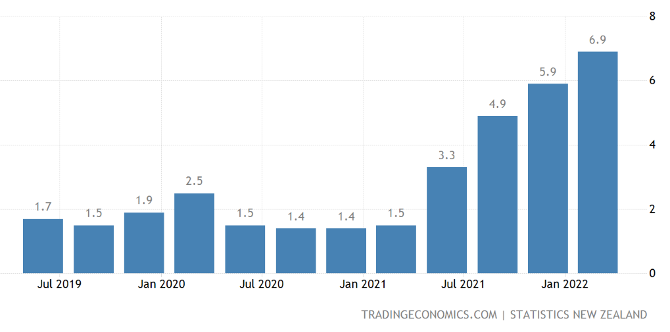
The above graph tracks the inflation rate in New Zealand.
Like elsewhere in the world, inflation in New Zealand continues to rise. The response by the NZ Reserve Bank is to raise interest rates, like elsewhere.
Interestingly, New Zealand was early with its interest rate response, and although it’s difficult to tell, there are some suggestions that we are getting near the peak of those interest rate rises. I think we’ll be better placed to know that over the next couple of months, depending what goes on in the US.
Bank Term Deposits
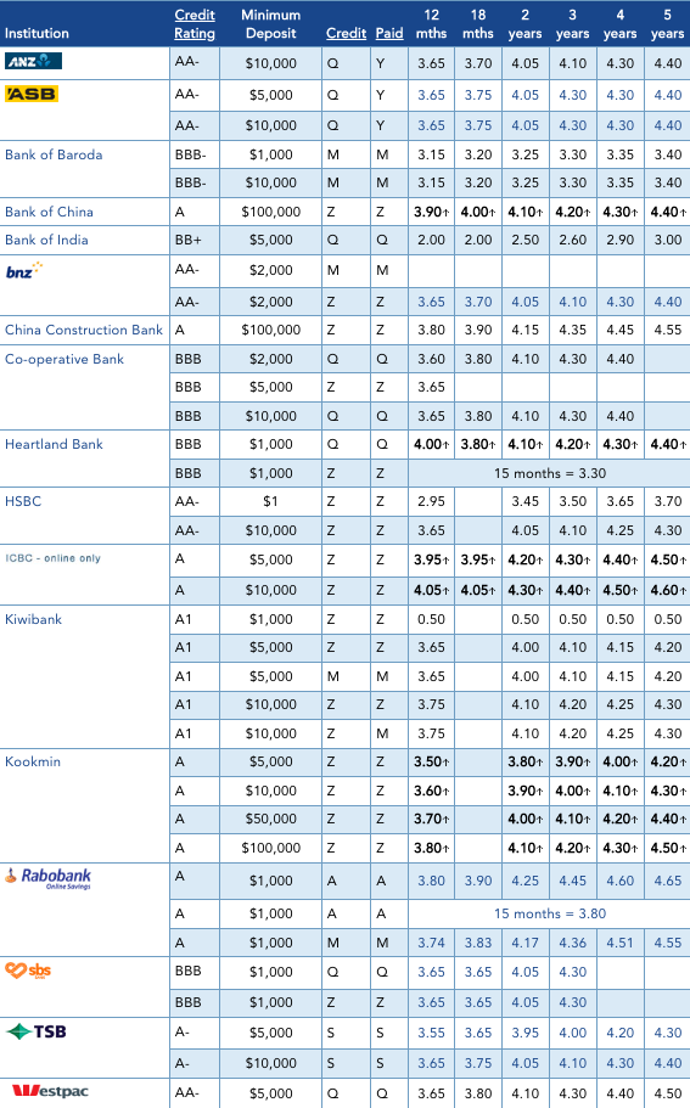
Bank Lending Rates
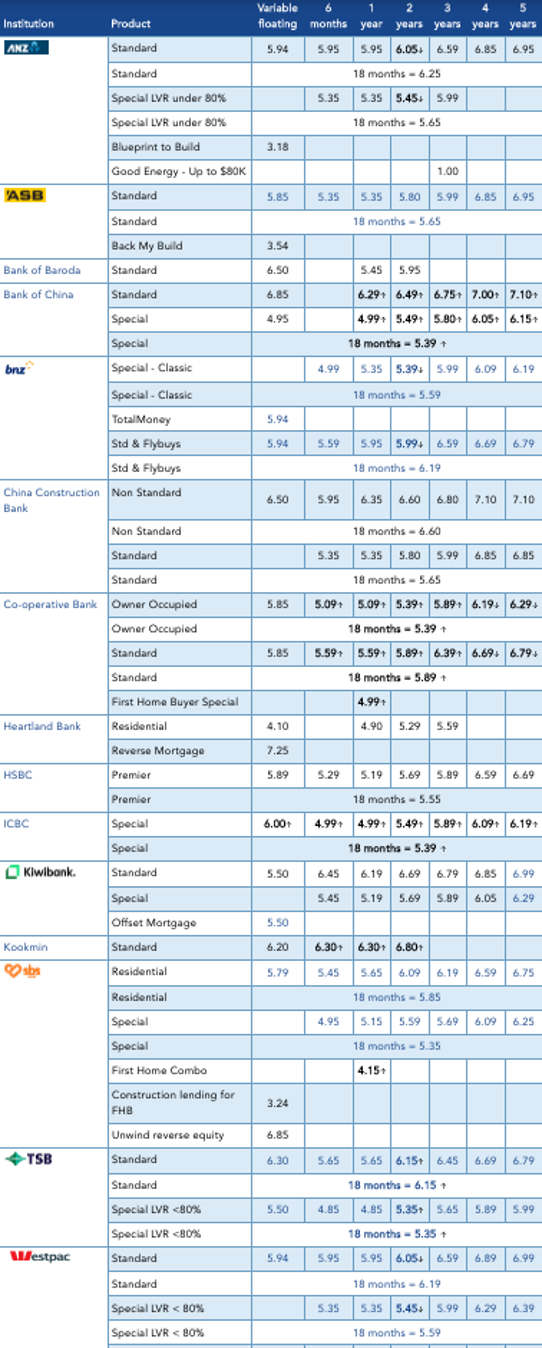
Term deposit rates and bank lending rates continue to rise. However, interest rates remain somewhat accommodative, and it’ll be interesting to see the New Zealand Reserve Bank announcements regarding the official cash rate over the next two meetings that are coming up soon.
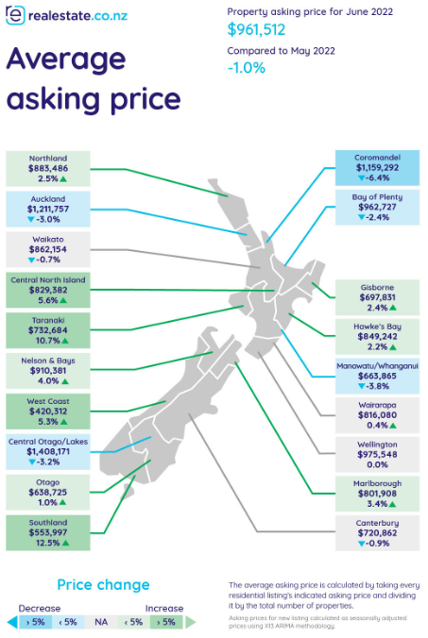
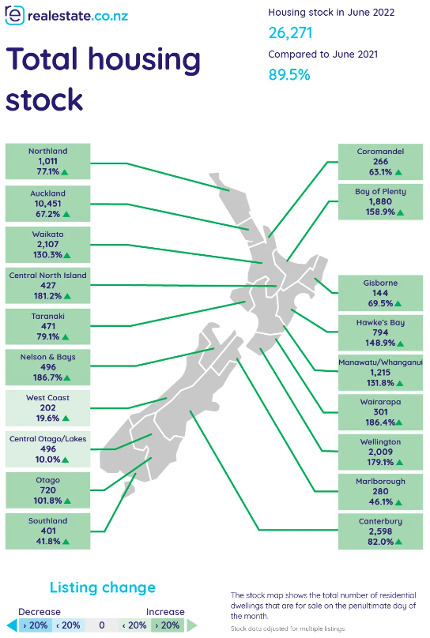
Property prices have declined in a number of areas across New Zealand, although generally prices remain relatively stable. There’s no sign of any property bubble bursting for example.
The availability of property stock is now significantly greater, which is helping to moderate prices.
New Zealand’s economy continues to move along at a modest pace, like many other economies dealing with spiking inflation.
Will rising living costs become politicised in New Zealand? I note recently that a grocery commissioner was appointed and it’ll be interesting to see what is achieved with yet another layer of compliance in New Zealand.
There will of course be benefits for everyday Kiwis, which is a good thing. Looking at the bigger picture though, the ongoing spending by the Labour Party is mounting up.
To Summarise …
Like last month, the ongoing uncertainty around the Ukraine situation, rising inflation and rising interest rates, along with unsettled markets, has not stopped the global economy from continuing to grow, albeit at a slower pace.
Still, economic growth of around 2% is not too bad. It may grow slower and there is even the chance of global recession.
As I’ve mentioned many times, this is not ideal as it does tend to disproportionately hurt those on lower incomes, but from an investment market and economic perspective, the wheels of commerce keep turning. Investors continue to invest. Everyday people and businesses still require those goods and services that large businesses provide.
The world may slow down a tad because of global economic recession but that’s a very different thing to depression, or indeed economic collapse, which some commentators suggest is possible – seriously!?
It is difficult to know how long the Ukraine situation will continue. Russia has recently (in theory at least) defaulted on its debt, the first time since around 1917.
Russia has a significant land mass. However, the Russian economy is not that big that it will destabilise the global economy (similar in size to the state of Texas in the US). The implications though of oil and gas shortages, particularly across Europe, are quite significant and part of what is driving inflation across Europe.
Interest rates around the world will continue to rise. It’s worth watching Jerome Powell, the US Federal Reserve Governor, and what he’s saying about interest rates. As I’ve outlined in previous Market and Economic Updates, the Fed dot plot is also worth looking at too. I will keep you posted though.
The Australian economy is holding up quite well, which is good because New Zealand trades quite a bit with Australia.
The New Zealand economy continues to grow, albeit at a modest pace. We have general economic stability overall, not withstanding the fact that markets have been volatile and are likely to remain so for the foreseeable future.
We are getting to the point though where at some stage, the market will decide that it’s worried enough about certain market and economic events and it will then focus on opportunity.
I’m not sure we’re at that point yet (not that I’m trying to time the markets), however trading prices for a number of the businesses that we recommend are fair value to favourable in some cases.
Opportunity is starting to emerge from an investment point of view, regardless of how doom and gloom it may all sound.
Indeed, one fund manager recently mentioned that, given all the negativity, we must be getting close to the bottom. We’ll see.
However, markets ultimately like growth, and inevitably, as this current market cycle shifts, the changes that take place are a natural part of that market cycle shift. This disruption changes the dynamic of markets, including pricing, so that we as investors once again have opportunity.
To be clear, investment opportunity doesn’t diminish when markets are volatile but rather, increases.

